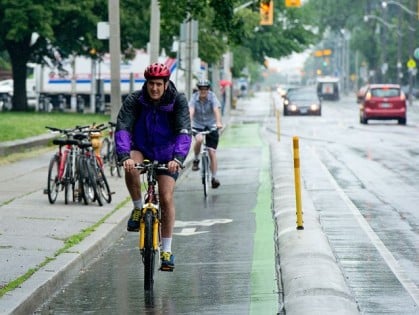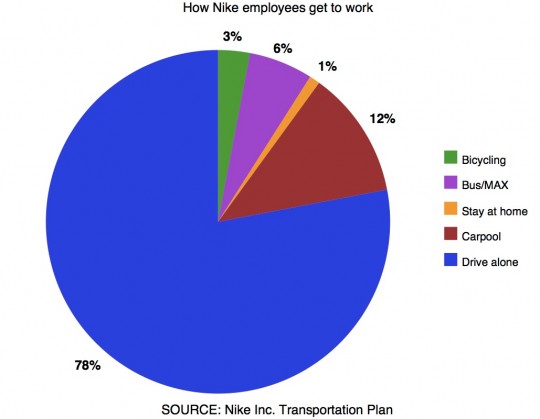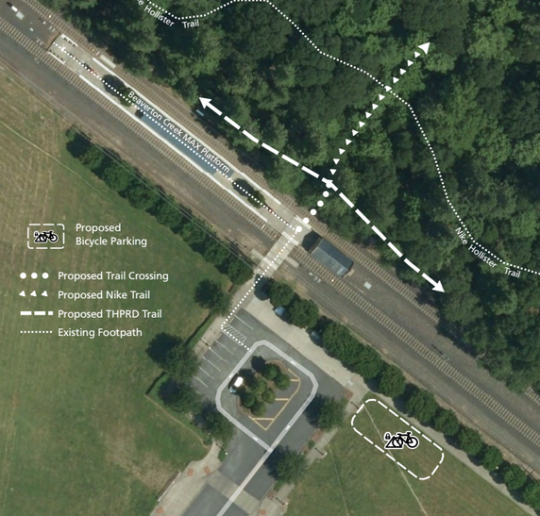
Road would serve Nike’s campus, but has
been delayed until 2019.
(Image: Washington County, modified by BikePortland)
Nike is planning to spend millions of dollars to build parking garages for 2,500 cars on its growing Washington County campus, but it’s not yet clear whether the sportswear giant will also be backing investments that would help its employees bike to work.
Today, 3 percent of Nike’s more than 8,000 payroll and contract workers typically walk or bike for their commute, according to a transportation plan covered last week by The Oregonian. Another 6 percent ride the bus or MAX, 1 percent telecommute, 12 percent carpool and 78 percent drive alone.
Though 3 percent biking and walking is probably well above average for a major employer in a U.S. suburb, it’s well below (for example) the 13 percent bike/walk rate at competitor Adidas, whose North American headquarters is in North Portland.
But aside from Nike’s momentous decision last year to choose Washington County for its expansion rather than Portland’s South Waterfront, there are signs that the company could be preparing for an investment in bike transportation.
Walker Road protected bike lane
We reported in January that Washington County was considering a 1.8-mile curb-protected bike lane along Walker Road, which runs along the north edge of Nike’s current campus and its planned expansion, as part of a road widening and sidewalk improvement. After a pair of open houses in the spring, though, the project’s build date was postponed two years, to late 2019.
Washington County Bicycle-Pedestrian Coordinator Shelley Oylear wrote in an email this month that Walker had been “delayed to better coordinate with building construction work on the Nike site. We want to minimize conflicts between construction traffic for the employees and residents and impacts to our new roadway that building construction will have. We are still moving forward projects in the vicinity, just re-ordered them, Jenkins Road and 158th are first up for improvements.”
Advertisement
Jenkins Road and 158th Avenue
According to The Oregonian, these streets along the south and west edges of Nike’s current campus (currently three and four general lanes plus striped gutter bike lanes) will also be widened to five lanes plus bike lanes. It’s not yet clear how wide those bike lanes will be or how they might be separated. (As we reported last year, the Federal Highway Administration’s official formula estimates that widening an intersection to add two mixed-traffic lanes makes it less safe to bike on, even when painted bike lanes are being added — and in this case, the streets already have painted lanes.)
The streets, which currently have irregular or unbuffered sidewalks, would likely get walking upgrades.
Path through woods to MAX stop
The possibility of a direct off-road link between Nike’s campus and the Beaverton Creek MAX station, running through a forested plot of land owned by Nike, came up earlier this year when TriMet won a state grant to improve bike access to the station. That grant application alluded to “a future north-south Nike trail through the Nike woods property.”
Also this year, Nike launched a corporate bike sharing system. It’s been popular enough as a quick connection to the MAX for TriMet to add additional bike staples at the MAX station.
It all seems like a strong sign that Nike is at least interested in the path. Last week, we asked TriMet active transportation planner Jeff Owen and Nike spokesman Greg Rossiter if they could share anything about that. Owen referred questions to Rossiter, who had this to say:
At this point, what we can tell you is that we expect to work with Washington County and the City of Beaverton to make improvements to the roads leading to and from campus, and we’re also considering a variety of mass transit options. We aren’t providing additional details at this time.





